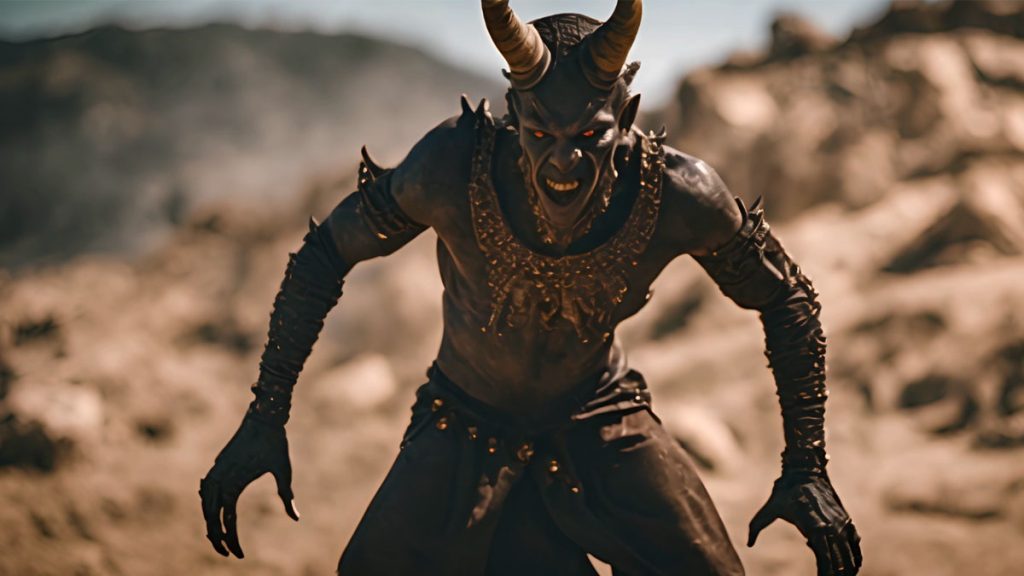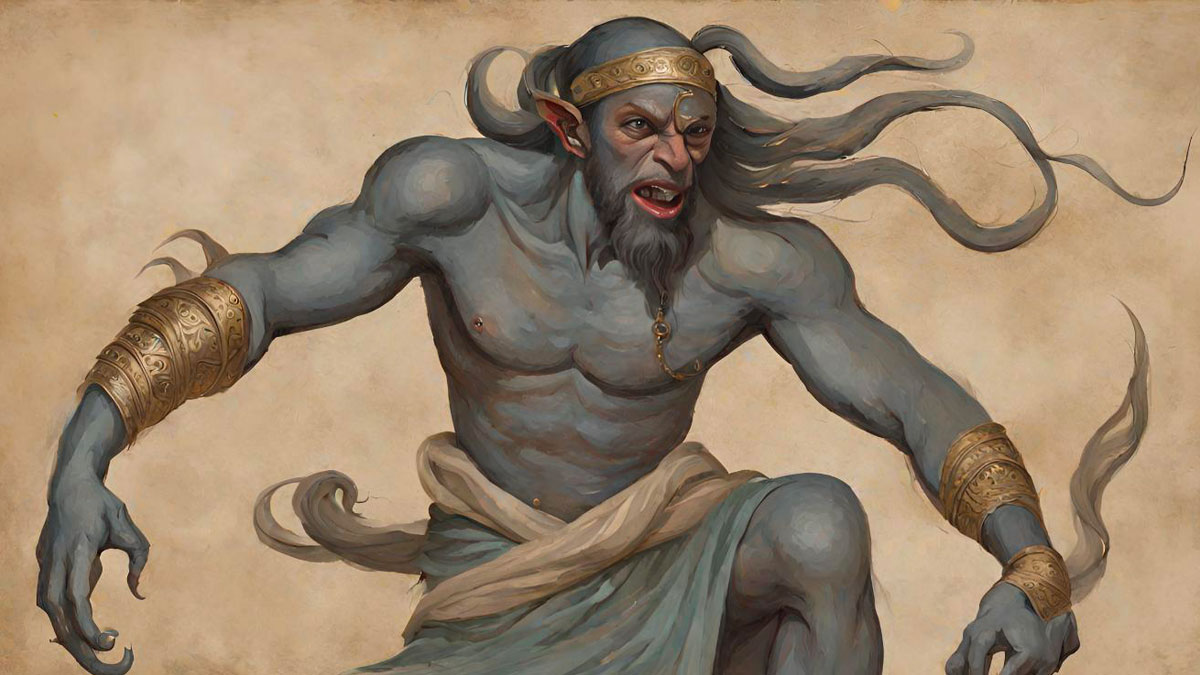Shaitan, often spelled as Shaytan or as Shayatin for the plural form, are evil spirits or demons prevalent within Islam and Arabic folklore and are featured in literature, myth, and storytelling throughout the Middle East and the Muslim world.
Shaitan is also one of the names given to the devil or satan. This evil creature is often known by the name Iblis or Iblees in Islam. The term Shaitan can refer to Iblis himself when he is performing evil deeds or to his demons performing his evil bidding.
These demons, including the devil, are often classed as a sub-section of Jinn. The Jinn are a type of mythical being that is between angels and humans. They are not immortal but live in a realm that is invisible to humans. However, whereas Jinn can be good or evil, Shaitans are exclusively evil. The 9th-century Arab writer al-Jāḥiẓ referred to them simply as unbelieving Jinn.
The word Jinn often becomes genie in English. It’s presumed the infamous genie portrayed in the story of Aladdin’s Lamp in the first book of the Middle Eastern folktale, the Thousand and One Nights (The Arabian Nights), was a Jinn and may have been a Shaitan.
Three major types of Shaitan – demons, the devil, or the evil within humans
The Shaitans are a little tricky to class because the word can have several meanings, and the mythology about them spans numerous centuries, regions, and differing religious teachings. Creatures referred to as Shaitan have taken many different roles and performed varying functions.
Before the emergence of Islam, pre-Muslim Arabs saw Shayatin as familiars, supernatural beings, or guardians who assisted humans in performing black magic. These demons were sometimes seen as Greek in origin.
Arabic folklore generally describes Shaitans as particularly hideous and unbelievably ugly creatures. They can be male or female and often assume human form, though their feet are always hooved.

There is a strong emphasis on how disgusting and dirty these demons can be; they allegedly eat excrement and spread diseases. Luckily, these creatures are mostly invisible to humans.
Shaitan demons and Iblis are not thought to have much in the way of actual power, but they do their best to influence humans and encourage them to perform evil deeds.
Within some Islamic teachings, the term Shaitan has also come to be used in a very broad sense to refer to all human actions that may be defined as any human action deemed immoral or evil. Shaitan can be perceived as more a state of mind than an actual creature. It is likened to an internal struggle between good and evil within a human and a struggle in which the human ultimately has control over which side wins.
This battle within is often personified as a Shaitan, which could be the Devil, Iblis himself, or one of his minions performing his evil bidding. These are rebellious creatures who are unwelcome in the spiritual, heavenly domain.
In the form of the devil, Iblis, Shaitan is generally portrayed as similar to the Christian devil, an angry, demonic-looking being with horns. Iblis is seen as hairless with bulging muscles and smoldering embers for eyes.
The Quran refers to Shaitans and the devil separately, but both are beings rebelling against God’s order and seek to disrupt by causing misery to humans. They do this by making evil suggestions to humans and jinns, hoping to cause disputes between people.
The Shaitan demons can also teach sorcery to humans and encourage the faithful to have doubts. They can lead unfortunate individuals into danger, such as into fire or simply far from home. They can also be blamed for many misfortunes that might befall an individual throughout their day and were even accused of making people forgetful.
Shaitan demons are often seen as responsible for most forms of vice and immorality, from encouraging people to live extravagant lifestyles to enticing some into committing murder.
It is important to remember that Shaitan demons and Iblis have no real power and can only rely on their ingenuity and persuasive powers to cause misery. Confusingly, although these rebellious creatures are rejected from heaven, they still remain largely under God’s control.
Origin of Iblis and the Shaiton demons
According to the Quran, Iblis, Shaiton demons, and the other Jinn were created long before humans. The Jinn were made from fire as opposed to humans, who were created from soil.
The Quran states that God commanded all the Jinn to bow before Adam, the first human, but Iblis and his Shaitan followers refused and were cast out of the heavenly sphere as punishment. Henceforth, Iblis and the Shaitan demons have worked to disrupt God’s order and tempt humans into committing evil deeds.
The Al-Kahf chapter of the Quran [18:50] explained how Shaitan, as the devil, turned evil:
“When We said to the angels, ‘Prostrate before Adam,’ they prostrated, but not Iblis. He was one of the jinn, so he transgressed against his Lord’s command. Will you then take him and his offspring for guardians in My stead, though they are your enemies? How evil a substitute for the wrongdoers!”
However, it should be noted that different Islamic scholars have interpreted and translated the Quran in different ways, and there is disagreement over the status of Iblis, with some scholars arguing that he is a fallen angel and not a Jinn or Shaitan.
How to defeat Shaitan
The Quran describes Shaitan in the form of Iblis the devil, as the true and most significant enemy of all humans. However, similarly to the Christian devil, Shaitan/Iblis can easily be defeated so long as you do not give in to his temptations.
It seems the best way to defeat a Shaitan is not to be fooled or tempted by Iblis or one of these demons. Within Islam, one must simply believe in God and not allow oneself to be led astray. The idea is that if one performs only good deeds to fellow humans, the Shaitan is left powerless.
Muslims can utter the Arabic phrase “A’oo Thu Billahi min Ash Shaitan Arrajim” (meaning: O God, I seek refuge in You, from Shaitan the rejected) before reciting the Quran, which will cast away any devil or Shaitan demons in the vicinity.
Shaitan in popular movie culture
Shaitan portrayed as either demons or the devil appear in multiple mediums, including movies. Turkish horror movie Semum was released in 2008, which dealt with Islamic themes directly related to Shaitan. The plot involves an ordinary woman whose body is taken over by a demon or Shaitan. Some movie critics have pointed out similar tropes and themes to the 1973 Hollywood movie The Exorcist; however’ Semum comes clearly from the Muslim tradition.
An Indian-produced movie, Shaitaan, is expected to be released in March 2024 and will chronicle the misfortunes of an Indian family who encounter an evil spirit while on vacation in a secluded town.
References
Al-Islam.org, “Iblis and Shaitans,” accessed March 4, 2024.
Britannica.com, “Shaitan: Islamic Mythology,” accessed March 4, 2024.
Cryptidz.fandom.com, “List of Jinn Types,” accessed March 4, 2024.
Enchantingardens.angelfire.com, “Genie,” accessed March 4, 2024.
Evil in Turkish Muslim horror film: the demonic in “Semum.” https://link.springer.com/article/10.1007/s43545-024-00832-w. Accessed March 4, 2024.
Lampofislam.com, “Meaning of Shaitan,” accessed March 4, 2024.
LaurelhillСemetery.blog, “What are the cultural roots of the Lamp of the Genie?” accessed March 4, 2024.
Themuslimvibe.com, “10 acts to stay away from to defeat Shaytan,” accessed March 4, 2024.
